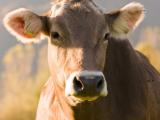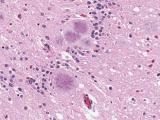Nov 3, 2003 (CIDRAP News) Saying the risk of bovine spongiform encephalopathy (BSE) in Canadian cattle is minimal, the US Department of Agriculture has proposed to reopen the US border to live Canadian cattle for the first time since BSE was discovered in one Alberta cow last May.
The USDA proposes to allow the importation of cattle under 30 months old and destined for slaughter before they reach that age. BSE, or mad cow disease, is very rarely found in cattle younger than 30 months.
"We are satisfied that this [BSE case] is an isolated case, and that mitigative and surveillance measures in place in Canada are more than adequate to prevent the spread of this disease," Bill Hawks, USDA under secretary for marketing and regulatory programs, said at an Oct 31 news conference in Washington, DC. A transcript of the conference was posted on the USDA Web site.
The USDA also announced that a new assessment by the Harvard Center for Risk Analysis shows that if BSE-infected cattle or animal feed entered the United States from Canada in recent years, it would not have spread widely. The 1997 ban on feeding protein from ruminants (cud-chewing animals) back to ruminants, along with other safeguards, would have contained the disease, the agency said. BSE is believed to spread when cattle eat feed containing protein from BSE-infected cattle.
"Even accounting for incomplete compliance with that feed ban, our analysis finds that had infected animals or feed come in from Canada or really from anywhere else, by now, the spread of BSE in the American cattle population would have been reversed, and human exposure to contaminated animal tissues would have been very low," Dr. George Gray, deputy director of the Harvard center, said at the news conference.
Eating meat products from BSE-infected cattle is thought to be the cause of variant Creutzfedlt-Jakob disease, a fatal neurologic condition in humans. The BSE agent, a prion protein, is found primarily in neural tissue such as brain and spinal cord.
The USDA is inviting comments until Jan 5, 2004, on its proposal to reopen the border to Canadian cattle. The agency will weigh the comments before making any decisions. At the news conference, officials refused to predict when the border would be reopened. "It would certainly be totally premature for us to attempt to do that," said Hawks.
When Canada announced May 20 that tissue from an Alberta cow had tested positive for BSE, the USDA immediately barred all imports of Canadian cattle, beef, and related products. Later the border was reopened for boneless meat from cattle up to 30 months old and veal from calves up to 36 weeks old, but permits are required, according to the USDA Animal and Plant Health Inspection Service (APHIS).
The new proposal would place Canada on "a list of countries considered minimal risk for BSE, thus making Canada eligible to export certain live ruminant and ruminant products," the USDA said in a news release. The plan would allow importation of cattle less than 30 months of age for immediate slaughter and cattle to be moved to a designated feedlot and then slaughtered before they reach 30 months.
The proposal would also allow importation of several other categories of ruminant products, such as fresh carcasses and meat from cattle less than 30 months old, sheep and goats less than a year old for immediate slaughter, "hunter-harvested wild ruminant products," and meat from farm-raised deer and elk.
The proposal would amend the USDA's BSE regulations by establishing a new category of minimal risk regions, where BSE has occurred but where "specific preventive measures have been in place for an appropriate period of time that reduce the risk of BSE being introduced to the United States," the agency said.
Officials said the proposed rule is consistent with the approach used by the World Organization for Animal Health (Organization Internationle des Epizooties)
The Harvard Center for Risk Analysis previously produced a lengthy analysis of the risk of BSE in the United States, releasing its report in December 2001. Shortly after the Canadian BSE case was discovered, the USDA asked the center to do a new assessment of the potential effects of a possible BSE introduction from Canada before that case turned up.
"Using our computer model, we did find that if BSE-containing cattle came into the United States as early as 1990, which was seven years before the FDA [Food and Drug Administration] feed ban was put in place, we could have had as many as 500 to 600 infected animals, and 25 percent of them would have become sick enough to show signs of mad cow disease," Gray said at the news conference. "But even under those circumstances, the feed ban, when it's introduced in 1997, chokes off the spread of the disease, so by now it would be well on its way to elimination or be gone entirely."
That scenario assumed the importation of five infected animals several years before the Alberta cow was apparently infected, Gray said. "If we go back instead and look at a scenario where BSE-infected animals came in to the United States in 1996 or 1998, then our model predicts only about two new cases of BSE, and the disease would be quickly eliminated," he added.
USDA officials were asked about the risk of BSE in cattle younger than 30 months, in view of the recent discovery of the disease in a 23-month-old bull in Japan. Dr. Elsie Ferguson said, "While we're aware that that has occurred, it's not the norm and the vast majority of animals that are positive are greater than 30 months of age." She added that research on the infectivity of bovine tissues indicates that central nervous system tissue is not likely to become infective until 32 months after exposure to BSE.
In other comments, USDA officials said they are considering a rule on the handling of "specified risk materials"cattle parts most likely to contain the BSE agentbut gave no details. In July, Canada announced that it would require the removal of the brain, spinal cord, terminal ileum, and certain nerve bundles from cattle carcasses at the time of slaughter.
See also:
USDA news release
http://www.usda.gov/documents/NewsReleases/2003/10/0372.doc
Transcript of Oct 31 USDA press conference
http://www.usda.gov/documents/NewsReleases/2003/10/0373.doc
















